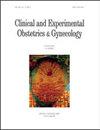Safety and efficacy of knotless barbed suture in cesarean section using postpartum ultrasound: a retrospective cohort study
IF 0.6
4区 医学
Q4 OBSTETRICS & GYNECOLOGY
引用次数: 1
Abstract
Background: While speed, safety, and efficacy are necessary in the operation of cesarean section (CS), a number of new devices have been introduced to support the technique. This retrospective study was conducted to assess the usability and safety of knotless barbed suture, compared to conventional method, for closure of uterine myometrium during cesarean section. Methods: Patients who underwent cesarean delivery at Korea University Ansan Hospital between August 2018 and December 2019 were reviewed. Surgical outcomes including uterine closure time, operating time, estimated blood loss, and sonographic results of residual myometrial thickness at the site of incision at 6 to 8 weeks after operation were analyzed. Results: Out of total 78 women, 44 patients had knotless barbed suture and 34 patients underwent conventional suture. Compared to conventional method, the uterine closure time was significantly reduced (p = 0.012). Operative time, estimated blood loss during operation, hemoglobin difference on the third operative day, and the number of cases with transfusion, postpartum infection, and bleeding demonstrated no significant differences between the two groups. At 6 to 8 weeks after operation, transvaginal ultrasound revealed no differences in residual myometrial scar thickness. Conclusion: Knotless barbed suture resulted in significantly shorter uterine closure time and no increased rate of perioperative complications. Our work supports that knotless barbed suture can be effectively used for cesarean section.产后超声剖宫产术中无结倒钩缝合的安全性和有效性:一项回顾性队列研究
背景:虽然剖宫产手术的速度、安全性和有效性是必要的,但已经引入了许多新的设备来支持这项技术。本回顾性研究旨在评估与传统方法相比,无节带倒钩缝线在剖宫产期间闭合子宫肌层的可用性和安全性。方法:对2018年8月至2019年12月在韩国大学安山医院接受剖宫产的患者进行回顾性分析。分析手术结果,包括子宫闭合时间、手术时间、估计失血量和术后6-8周切口处残余肌层厚度的超声结果。结果:在总共78名女性中,44名患者采用了无节倒钩缝合,34名患者采用常规缝合。与传统方法相比,子宫闭合时间显著缩短(p=0.012)。两组的手术时间、术中估计出血量、第三个手术日的血红蛋白差异以及输血、产后感染和出血的病例数均无显著差异。术后6至8周,经阴道超声显示残余子宫肌层瘢痕厚度没有差异。结论:无结倒刺缝合显著缩短了子宫闭合时间,围手术期并发症发生率没有增加。我们的工作支持无节倒钩缝线可以有效地用于剖宫产。
本文章由计算机程序翻译,如有差异,请以英文原文为准。
求助全文
约1分钟内获得全文
求助全文
来源期刊
CiteScore
0.50
自引率
0.00%
发文量
241
审稿时长
1 months
期刊介绍:
CEOG is an international, peer-reviewed, open access journal. CEOG covers all aspects of Obstetrics and Gynecology, including obstetrics, prenatal diagnosis, maternal-fetal medicine, perinatology, general gynecology, gynecologic oncology, uro-gynecology, reproductive medicine, infertility, reproductive endocrinology, sexual medicine. All submissions of cutting-edge advances of medical research in the area of women''s health worldwide are encouraged.

 求助内容:
求助内容: 应助结果提醒方式:
应助结果提醒方式:


